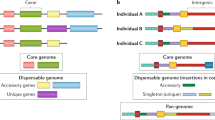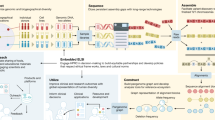Abstract
Genome sequencing projects have been undertaken in one of three ways: in a purpose-built and professionally staffed genome centre, by a small number of traditional research laboratories or by an extensive network of traditional research laboratories that are linked by the Internet. Sequencing networks are an attractive option in many circumstances as they are easy to create, bring together diverse types of expertise, integrate the eventual users of a genome sequence with its determination and generally foster a collaborative spirit.
This is a preview of subscription content, access via your institution
Access options
Subscribe to this journal
Receive 12 print issues and online access
$189.00 per year
only $15.75 per issue
Buy this article
- Purchase on Springer Link
- Instant access to full article PDF
Prices may be subject to local taxes which are calculated during checkout


Similar content being viewed by others
References
Fleischmann, R. D. et al. Whole-genome random sequencing and assembly of Haemophilus influenzae Rd. Science 269, 496–512 (1995).
Goffeau, A. et al. Life with 6000 genes. Science 274, 546, 563–546, 567 (1996).
Favello, A., Hillier, L. & Wilson, R. K. Genomic DNA sequencing methods. Methods Cell Biol. 48, 551–569 (1995).
Fraser, C. M. & Fleischmann, R. D. Strategies for whole microbial genome sequencing and analysis. Electrophoresis 18, 1207–1216 (1997).
Stein, L. Genome annotation: from sequence to biology. Nature Rev. Genet. 2, 493–503 (2001).
Ridgeway, S. & Reddy, M. Residue levels of several organochlorines in tursiops-truncatus milk collected at varied stages of lactation. Mar. Pollut. Bull. 30, 609–614 (1995).
Blattner, F. R. et al. The complete genome sequence of Escherichia coli K-12. Science 277, 1453–1474 (1997).
Chambaud, I. et al. The complete genome sequence of the murine respiratory pathogen Mycoplasma pulmonis. Nucleic Acids Res. 29, 2145–2153 (2001).
Andersson, S. G. et al. The genome sequence of Rickettsia prowazekii and the origin of mitochondria. Nature 396, 133–140 (1998).
Kunst, F. et al. The complete genome sequence of the Gram-positive bacterium Bacillus subtilis. Nature 390, 249–256 (1997).
Simpson, A. J. et al. The genome sequence of the plant pathogen Xylella fastidiosa. The Xylella fastidiosa Consortium of the Organization for Nucleotide Sequencing and Analysis. Nature 406, 151–157 (2000).
Dias, N. E. et al. Shotgun sequencing of the human transcriptome with ORF expressed sequence tags. Proc. Natl Acad. Sci. USA 97, 3491–3496 (2000).
Bonalume Neto, R. Brazilian scientists team up for cancer genome project. Nature 398, 450 (1999).
Camargo, A. A. et al. The contribution of 700,000 ORF sequence tags to the definition of the human transcriptome. Proc. Natl Acad. Sci. USA 98, 12103–12108 (2001).
Simpson, A. J. & Perez, J. F. ONSA, the São Paulo Virtual Genomics Institute. Organization for Nucleotide Sequencing and Analysis. Nature Biotechnol. 16, 795–796 (1998).
Shirai, M. et al. Comparison of whole genome sequences of Chlamydia pneumoniae J138 from Japan and CWL029 from USA. Nucleic Acids Res. 28, 2311–2314 (2000).
Hayashi, T. et al. Complete genome sequence of enterohemorrhagic Escherichia coli O157:H7 and genomic comparison with a laboratory strain K-12. DNA Res. 8, 11–22 (2001).
Ng, W. V. et al. Genome sequence of Halobacterium species NRC-1. Proc. Natl Acad. Sci. USA 97, 12176–12181 (2000).
Kuroda, M. et al. Whole genome sequencing of meticillin-resistant Staphylococcus aureus. Lancet 357, 1225–1240 (2001).
She, Q. et al. The complete genome of the crenarchaeon Sulfolobus solfataricus P2. Proc. Natl Acad. Sci. USA 98, 7835–7840 (2001).
Acknowledgements
I thank the hundreds of scientists, students and associates who have made genomics such a telling reality in Brazil. In addition, I thank F. Perez (Scientific Director of FAPESP), L. Old (Scientific Director of the Ludwig Institute) and R. Brentani (Director of the São Paulo Branch of the Ludwig Institute) for their continuing support and encouragement, and without whom network-based genome sequencing would not have been established in the state of São Paulo. I am also grateful to O. Caballero and A. Vettore for their critical reading of this manuscript. The sequencing of X. fastidiosa, X. citri, X. campestris, and L. xyli has been funded principally by FAPESP, and the national genome project to sequence C. violaceum has been coordinated and funded exclusively by the Ministério de Ciência e Tecnologia (MCT) in conjunction with Conselho Nacional de Desenvolvimento Cíentifico de Tecnológico (CNPq).
Author information
Authors and Affiliations
Related links
Related links
FURTHER INFORMATION
TIGR Comprehensive Microbial Resource
Dedicated sequencing centres
Sequencing consortia
Rights and permissions
About this article
Cite this article
Simpson, A. Genome sequencing networks. Nat Rev Genet 2, 979–983 (2001). https://doi.org/10.1038/35103503
Issue Date:
DOI: https://doi.org/10.1038/35103503
This article is cited by
-
Reviews and comment from nature journals
Nature Reviews Cancer (2001)



